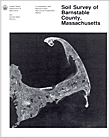The following is a map unit description from the "Soil Survey of Barnstable County, Massachusetts (Fletcher, 1993)"

HoD-Hooksan sand, hilly. This very deep, hilly and steep, excessively drained soil is on vegetated sand dunes along the coast. Slopes are complex and generally range from 15 to 35 percent. The soil makes up about 0.9 percent (2,325 acres) of the survey area. It is mapped in the Hooksan-Beaches-Dune land general soil map unit. Areas are elongated or irregular in shape and parallel the shoreline. They range from 10 to 200 acres in size.
Typically, the surface layer is pale brown, loose sand about 20 inches thick. The upper part of the substratum also is pale brown, loose sand. The lower part to a depth of 65 inches or more is light yellowish brown, loose sand.
Included with this soil in mapping are small areas of Berryland, Ipswich, Matunuck, Pawcatuck, and Pipestone soils; small, narrow areas of Beaches; and areas of Dune land, which are not vegetated. Also included, in Provincetown, are wooded areas of Hooksan soils that commonly have a better developed profile than this Hooksan soil. Included areas make up about 1 0 percent of this unit.
Permeability is very rapid throughout the Hooksan soil. Available water capacity is very low. Depth to the seasonal high water table is more than 6 feet.
Most areas support beachgrass. Many areas in Provincetown are wooded. Some areas support low shrubs.
This soil is unsuited to cultivated crops, hay, and pasture because of droughtiness, low fertility, and the slope.
This soil is poorly suited to trees. Establishing trees is difficult because of the droughtiness and low fertility of the soil. Because the soil is close to salt water, the strong prevailing winds and salt spray severely limit tree growth. The common vegetation includes beachgrass, poison ivy, beach plum, and bayberry.
This soil is generally unsuited to most nonfarm uses because of the slope, the very rapid permeability, and the susceptibility to erosion after the plant cover has been disturbed.